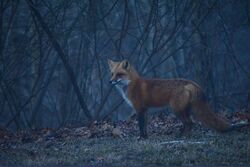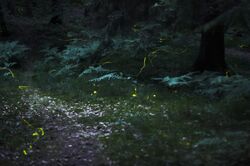Biology:Crepuscular animal

In zoology, a crepuscular animal is one that is active primarily during the twilight period,[1] being matutinal, vespertine/vespertinal, or both. This is distinguished from diurnal and nocturnal behavior, where an animal is active during the hours of daylight and of darkness, respectively. Some crepuscular animals may also be active by moonlight or during an overcast day. Matutinal animals are active only before sunrise, and vespertine only after sunset.
A number of factors affect the time of day an animal is active. Predators hunt when their prey is available, and prey try to avoid the times when their principal predators are at large. The temperature may be too high at midday or too low at night.[2] Some creatures may adjust their activities depending on local competition.
Etymology and usage
The word crepuscular derives from the Latin crepusculum ("twilight").[3] Its sense accordingly differs from diurnal and nocturnal behavior, which respectively peak during hours of daylight and darkness. The distinction is not absolute, because crepuscular animals may also be active on a bright moonlit night or on a dull day. Some animals casually described as nocturnal are in fact crepuscular.[2]
Special classes of crepuscular behaviour include matutinal, or "matinal", animals active only in the dawn, and vespertine, only in the dusk. Those active during both times are said to have a bimodal activity pattern.
Adaptive relevance
The various patterns of activity are thought to be mainly antipredator adaptations, though some could equally well be predatory adaptations.[4] Many predators forage most intensively at night, whereas others are active at midday and see best in full sun. The crepuscular habit may both reduce predation pressure, increasing the crepuscular populations, and offer better foraging opportunities to predators that increasingly focus their attention on crepuscular prey until a new balance is struck. Such shifting states of balance are often found in ecology.
Some predatory species adjust their habits in response to competition from other predators. For example, the subspecies of short-eared owl that lives on the Galápagos Islands is normally active during the day, but on islands like Santa Cruz that are home to the Galapagos hawk, the owl is crepuscular.[5][6]
Apart from the relevance to predation, crepuscular activity in hot regions also may be the most effective way of avoiding heat stress while capitalizing on available light.
Crepuscular flight activity is preferred by some animals, such as the walnut twig beetle, due to warmer temperatures, moderate wind speeds, and low barometric pressure.[7]
Crepuscular activity can be influenced by the lunar cycle due to the change in nocturnal light. This creates changes in animal sleep, reproduction, and foraging behaviours, often becoming less active during periods of low light.[8]
Migration
Animal patterns of activity sometimes change during migration due to changes in environmental conditions. Mule deer are crepuscular, but they are only active at sunset before and during migration. In the spring they are only active at sunrise because the snow is at its hardest, so it is easier for the deer to move without sinking in the snow.[9]
During migration, some types of swallow are active primarily during daytime hours with some activity during twilight hours.[10]
Human impact on crepuscular behaviour
Crepuscular animal activity is affected by human activity, because humans are diurnal. Crepuscular animals are less likely to participate in typical foraging or reproductive behaviors and deal with increased stress and mortality rates when humans are present.[11] Animals may change their usual activity patterns in response to the presence of humans. For example, Asian black bears may avoid areas with high human activity during the day, but go to these locations during twilight or nighttime hours.[12]
Light pollution impacts crepuscular behaviour because it mimics natural light conditions, leading crepuscular animals to behave as they would on nights with more moonlight.[8]
Occurrence of crepuscular behaviour

Many familiar mammal species are crepuscular, including the endangered Amazon river dolphin, some species of bats,[2] hamsters, housecats, stray dogs,[13] rabbits,[2] ferrets,[14] rats,[15] jaguars, ocelots, bobcats, servals, strepsirrhines, red pandas, bears,[16] deer,[2][17] moose, sitatunga, capybaras, chinchillas, the common mouse, skunks, squirrels, foxes, wombats, wallabies, quolls, possums[2] and marsupial gliders, tenrecs, and spotted hyenas.
Snakes, lizards, and frogs,[18] especially those in desert environments, may be crepuscular.[2]
Crepuscular birds include the common nighthawk, barn owl,[19] owlet-nightjar, chimney swift, American woodcock, spotted crake, white-breasted waterhen,[20] European nightjars,[8] and common buzzards.[21]
Many moths, beetles, flies, and other insects are crepuscular and vespertine.[citation needed]
See also
References
- ↑ "Glossary". North American Mammals. Smithsonian – National Museum of Natural History. https://naturalhistory.si.edu/mna/glossary.cfm.
- ↑ 2.0 2.1 2.2 2.3 2.4 2.5 2.6 "Crepuscular". Macmillan Science Library: Animal Sciences. Macmillan Reference. 2001–2006. http://www.bookrags.com/research/crepuscular-ansc-01/. Retrieved 2011-07-11.
- ↑ Winn, Philip (2001). Dictionary of Biological Psychology. Taylor & Francis. ISBN 0415136067. https://archive.org/details/dictionaryofbiol0000unse.
- ↑ Caro, Tim (2005) (in en). Antipredator Defenses in Birds and Mammals. University of Chicago Press. ISBN 978-0226094366. https://books.google.com/books?id=2i0tCgP_GbwC&q=crepuscular&pg=PR5.
- ↑ Frederick, Prince (2006-04-15). "Night herons in the day!". The Hindu. http://www.hindu.com/mp/2006/04/15/stories/2006041502340100.htm.
- ↑ Merck, John. "The community of terrestrial animals". Field Studies II: The Natural History of the Galápagos Islands. University of Maryland Department of Geology. http://www.geol.umd.edu/~jmerck/GEOL388/lectures/07.html.
- ↑ Chen, Yigen; Seybold, Steven J. (2014-08-26). "Crepuscular Flight Activity of an Invasive Insect Governed by Interacting Abiotic Factors" (in en). PLOS ONE 9 (8): e105945. doi:10.1371/journal.pone.0105945. ISSN 1932-6203. PMID 25157977. Bibcode: 2014PLoSO...9j5945C.
- ↑ 8.0 8.1 8.2 Evens, Ruben; Kowalczyk, Céline; Norevik, Gabriel; Ulenaers, Eddy; Davaasuren, Batmunkh; Bayargur, Soddelgerekh; Artois, Tom; Åkesson, Susanne et al. (2020-06-09). "Lunar synchronization of daily activity patterns in a crepuscular avian insectivore". Ecology and Evolution 10 (14): 7106–7116. doi:10.1002/ece3.6412. ISSN 2045-7758. PMID 32760515. PMC 7391349. http://dx.doi.org/10.1002/ece3.6412.
- ↑ Jakopak, Rhiannon P.; Sawyer, Hall; LaSharr, Tayler N.; Randall, Jill; Dwinnell, Samantha P. H.; Fralick, Gary L.; Monteith, Kevin L. (2022-10-01). "Diel timing of migration is not plastic in a migratory ungulate" (in en). Animal Behaviour 192: 51–62. doi:10.1016/j.anbehav.2022.07.008. ISSN 0003-3472. https://www.sciencedirect.com/science/article/pii/S0003347222001981.
- ↑ Imlay, Tara L.; Taylor, Philip D. (2020-07-22). "Diurnal and crepuscular activity during fall migration for four species of aerial foragers". The Wilson Journal of Ornithology 132 (1): 159. doi:10.1676/1559-4491-132.1.159. ISSN 1559-4491. https://bioone.org/journals/the-wilson-journal-of-ornithology/volume-132/issue-1/1559-4491-132.1.159/Diurnal-and-crepuscular-activity-during-fall-migration-for-four-species/10.1676/1559-4491-132.1.159.full.
- ↑ Nix, Joshua H.; Howell, Ryan G.; Hall, Lucas K.; McMillan, Brock R. (2018-01-01). "The influence of periodic increases of human activity on crepuscular and nocturnal mammals: Testing the weekend effect" (in en). Behavioural Processes 146: 16–21. doi:10.1016/j.beproc.2017.11.002. ISSN 0376-6357. PMID 29122640. https://www.sciencedirect.com/science/article/pii/S0376635717301948.
- ↑ Ikeda, Takashi; Higashide, Daishi; Shichijo, Tomoya (2022-12-01). "Impact of human disturbance in Japan on the distribution and diel activity pattern of terrestrial mammals" (in en). Journal for Nature Conservation 70: 126293. doi:10.1016/j.jnc.2022.126293. ISSN 1617-1381. https://www.sciencedirect.com/science/article/pii/S1617138122001662.
- ↑ Beck, Alan M. (2002). The Ecology of Stray Dogs: A Study of Free-Ranging Urban Animals. Purdue University Press. ISBN 978-1557532459. https://books.google.com/books?id=9k11of3lHJUC&pg=PA12. Retrieved 2012-04-13.
- ↑ Williams, David L. (2012). Ophthalmology of Exotic Pets. John Wiley & Sons. pp. 73, 88. ISBN 978-1444361254. https://books.google.com/books?id=83trTlCQbFsC&pg=PA88. Retrieved 2017-06-23.
- ↑ Williams, David L. (2012). Ophthalmology of Exotic Pets. John Wiley & Sons. pp. 73, 88. ISBN 978-1444361254. https://books.google.com/books?id=83trTlCQbFsC&pg=PA88. Retrieved 2017-06-23.
- ↑ Schaul, Jordan Carlton (April 6, 2011). "The Kodiak Cubs Meet Their Neighbors, The American Black Bears". National Geographic Voices. National Geographic Society. http://voices.nationalgeographic.com/2011/04/06/the-kodiak-cubs-meet-their-neighbors-the-american-black-bears/.[|permanent dead link|dead link}}]
- ↑ "White-Tailed Deer". Animals. National Geographic Partners, LLC. 12 March 2010. http://www.nationalgeographic.com/animals/mammals/w/white-tailed-deer/.
- ↑ Robertson, Jeanne M.; Bell, Rayna C.; Loew, Ellis R. (2022-06-01). "Vision in dim light and the evolution of color pattern in a crepuscular/nocturnal frog" (in en). Evolutionary Ecology 36 (3): 355–371. doi:10.1007/s10682-022-10173-w. ISSN 1573-8477. https://doi.org/10.1007/s10682-022-10173-w.
- ↑ Audubon, John J. (1827–1838). "Plate 171: Barn Owl". Birds of America. http://www.audubon.org/birds-of-america/barn-owl.
- ↑ Boyes, Steve (October 7, 2012). "Top 25 Wild Bird Photographs of the Week #23". National Geographic Voices. National Geographic Society. http://voices.nationalgeographic.com/2012/10/07/top-25-wild-bird-photographs-of-the-week-23/.
- ↑ Mioduszewska, Berenika; O’Hara, Mark; Stryjek, Rafał (5 November 2021). "Novelty at dawn: Exploration, low neophobia and crepuscular activity in a wild Common Buzzard ( Bu teo buteo )" (in en). Avian Biology Research 14 (4): 143–148. doi:10.1177/17581559211052422. ISSN 1758-1559. http://journals.sagepub.com/doi/10.1177/17581559211052422.
 |




